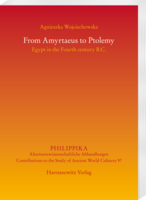|
weitere Titel zum Thema:
Download:
Bitte beachten Sie: Mit digitalen Produkten in Ihrem Warenkorb
wird die Bezahlung nur per PayPal möglich. Der Download dieser Produkte wird bereitgestellt, wenn die Bezahlung bestätigt ist. This book covers the history of Egypt between 404 BC and 305 BC. These are symbolic dates: the first one marked by the Persian empire losing control of Egypt to the native prince Amyrtaeus of the XXVIII dynasty, the second one by the coronation of Ptolemy I, who thus accentuated the beginning of a new Macedonian dynasty and the symbolic end of the Empire of Alexander the Great. From 404 until ca 340 BC Egypt stayed independent under the energetic pharaohs of the XXVIII-XXX dynasties, to reach its height of power during the reigns of Nectanebo I and Nectanebo II. In addition to accounts of classical authors, power and wealth of the pharaohs of the XXX dynasty are evidenced by their massive building program, as shown by the Catalogue of Buildings at the end of the book. Agnieszka Wojciechowska further shows the Second Persian Domination as a period of mostly military occupation contested by large parts of the population of Egypt who offered a more hospitable welcome to Alexander and his Argead successors.
In its reconstruction of the history of Egypt this book attempts to go beyond accounts of classical authors, making use of Greek and Egyptian inscriptions, coins, papyri and archaeological evidence. Fourth century papyri, largely sale and marriage contracts and tax documents, show economic and everyday life almost undisturbed by warfare. Their concentration in upper Egypt (Edfu, Elephantine) may suggest that the South of Egypt developed more intensively than the North – all the time exposed to Persian attacks. The evidence of coin hoards shows a very high proportion of local imitation of Athenian drachms among coinage of Egypt in the fourth century BC, with a marked rise of monetization in the Macedonian age. |
|||||||||||||||||||||||||||||||||||||||






